Q.1. Convert each of the following into a fraction in its simplest form:
(i) .8
(ii) .75
(iii) .06
(iv) .285
Ans. We have:
(i) 0.8 = 8/10 = (8÷2) / 10÷2 = 4/5
(ii) 0.75 = 75/100 = (75÷25) / (100÷25) = 3/4
(iii) 0.06 = 6/100 = (6÷2) / (100÷2) =3/50
(iv) 0.285 = 285/1000 = (285÷5) / (1000÷5) =57/200
Q.2. Convert each of the following as a mixed fraction:
(i) 5.6
(ii) 12.25
(iii) 6.004
(iv) 4.625
Ans. We have:
(i) 5.6 = 56/10 = (56÷2) / (10÷2) = 28/5 =
(ii) 12.25 = 1225/100 =(1225÷25) / 100÷25 = 49/4 =
(iii) 6.004= 6004/1000 = (6004÷4) / (1000÷4) = 1501/250 = 
(iv) 4.625 = 4625/1000 =(4625÷125) / (1000÷125) = 37/8 =
Q.3. Convert each of the following into like decimals:
(i) 47/10
(ii) 156/100
(iii) 2516/100
(iv) 3524/1000
(v) 25/8
(vi)
(vii)
(viii) 17/20
Ans. (i) 47/10
On dividing, we get:

∴ 47/10 = 4.7
(ii) 156/100
On dividing, we get:
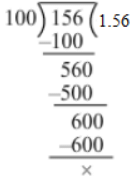
∴156/100 = 1.56
(iii) 2516/100
On dividing, we get:
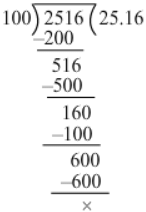
∴ 2516/100 = 25.16
(iv) 3524/1000
On dividing, we get:
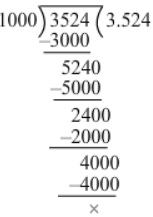
∴ 3524/1000 = 3.524
(v) 25/8
On dividing, we get:
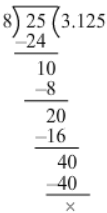
∴ 25/8 = 3.125
(vi)  =17/5
=17/5
On dividing, we get:

∴ 17/5 = 3.4
(vii) =52/25
=52/25
On dividing, we get:
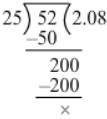
∴ 52/25 = 2.08
(viii) 17/20
On dividing, we get:
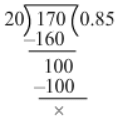
∴ 17201720 = 0.85
Q.4. Convert each of the following into like decimals:
(i) 6.5, 16.03, 0.274, 119.4
(ii) 3.5, 0.67, 15.6, 4
Ans. Converting the given decimals into like decimals, we have:
(i) 6.500, 16.030, 0.274 and 119.400
(ii) 3.50, 0.67, 15.60 and 4.00
Q.5. Fill in each of the place holders with the correct symbol > or <.
(i) 78.23 69.85
69.85
(ii) 3.406 3.46
3.46
(iii) 5.68 5.86
5.86
(iv) 14.05 14.005
14.005
(v) 1.85 1.805
1.805
(vi) 0.98 1.07
1.07
Ans. We have,
(i) Comparing the whole number part, 78 > 69.
Thus, 78.23 > 69.85
(ii) Converting the decimals into like decimals, we get 3.406 and 3.460.
Comparing the whole number parts, 3 = 3
Comparing the tenths digit, 4 = 4
Comparing the hundredths digit, 6 > 0
Thus, 3.406 < 3.46
(iii) Comparing the whole number parts, 5 = 5
Comparing the tenths digit, 6 < 8
Thus, 5.68 < 5.86
(iv) Converting the decimals into like decimals, we get 14.050 and 14.005.
Comparing the whole number parts, 14 = 14
Comparing the tenths digit, 0 = 0
Comparing the hundredths digit, 5 > 0
Thus, 14.05 > 14.005
(v) Converting the decimals into like decimals, we get 1.850 and 1.805.
Comparing the whole number parts, 1 = 1
Comparing the tenths digit, 8 = 8
Comparing the hundredths digit, 5 > 0
Thus, 1.85 > 1.805
(vi) Comparing the whole number parts, 0 < 1
Thus, 0.98 < 1.07
Q.6. Arrange the following decimals in ascending order:
(i) 4.6, 7.4, 4.58, 7.32, 4.06
(ii) 0.5, 5.5, 5.05, 0.05, 5.55
(iii) 6.84, 6.48, 6.8, 6.4, 6.08
(iv) 2.2, 2.202, 2.02, 22.2, 2.002
Ans. (i) Converting the given decimals into like decimals, we get:
4.60, 7.40, 4.58, 7.32, 4.06
Clearly, 4.06 < 4.58 < 4.60 < 7.32 < 7.40
Hence, the given decimals in ascending order are 4.06, 4.58, 4.6, 7.32 and 7.4.
(ii) Converting the given decimals into like decimals, we get:
0.50, 5.50, 5.05, 0.05, 5.55
Clearly, 0.05 < 0.50 < 5.05< 5.50 < 5.55
Hence, the given decimals in ascending order are 0.05, 0.5, 5.05, 5.5 and 5.55.
(iii) Converting the given decimals into like decimals, we get:
6.84, 6.48, 6.80, 6.40, 6.08
Clearly, 6.08 < 6.40 < 6.48 < 6.80< 6.84
Hence, the given decimals in ascending order are 6.08, 6.4, 6.48, 6.8 and 6.84.
(iv) Converting the given decimals into like decimals, we get:
2.200, 2.202, 2.020, 22.200, 2.002
Clearly, 2.002 < 2.020 < 2.200 < 2.202 < 22.200
Hence, the given decimals in ascending order are 2.002, 2.02, 2.2, 2.202 and 22.2.
Q.7. Arrange the following decimals in descending order:
(i) 7.4, 8.34, 74.4, 7.44, 0.74
(ii) 2.6, 2.26, 2.06, 2.007, 2.3
Ans. (i) Converting the given decimals into like decimals, we get:
7.40, 8.34, 74.40, 7.44, 0.74
Clearly, 74.40 > 8.34 > 7.44 > 7.40 > 0.74
Hence, the given decimals in descending order are 74.4, 8.34, 7.44, 7.4 and 0.74.
(ii) Converting the given decimals into like decimals, we get:
2.600, 2.260, 2.060, 2.007, 2.300
Clearly, 2.600 > 2.300 > 2.260 > 2.060 > 2.007
Hence, the given decimals in descending order are 2.6, 2.3, 2.26, 2.06 and 2.007.
Q.8. Express 45 mm in cm, m and km.
Ans. 45 mm = 45/10 cm = 4.5 cm
= 4.5 cm = 4.5/100 m = 0.045 m
= 0.045 m = 0.045/1000 km = 0.000045 km
∴ 45 mm = 4.5 cm = 0.045 m = 0.000045 km
Q.9. Express as rupees using decimals:
(i) 8 paise
(ii) 9 rupees 75 paise
(iii) 8 rupees 5 paise
Ans. We have:
(i) 8 paise = Rs 8/100 = Rs 0.08
(ii) 9 rupees 75 paise = Rs (9+75/100) = Rs (9 + 0.75) = Rs 9.75
(iii) 8 rupees 5 paise = Rs (8+ 5/100) = Rs (8 + 0.05) = Rs 8.05
Q.10. Express in km using decimals:
(i) 65 m
(ii) 284 m
(iii) 3 km 5 m
Ans. We have:
(i) 65 m = 65/1000 km = 0.065 km
∴ 65 m = 0.065 km
(ii) 284 m = 284/1000 km = 0.284 km
(iii) 3 km 5 m = (3+ 5/1000) = (3+ 0.005) = 3.005 km











 =17/5
=17/5
 =52/25
=52/25

 69.85
69.85 3.46
3.46 5.86
5.86 14.005
14.005 1.805
1.805 1.07
1.07




















